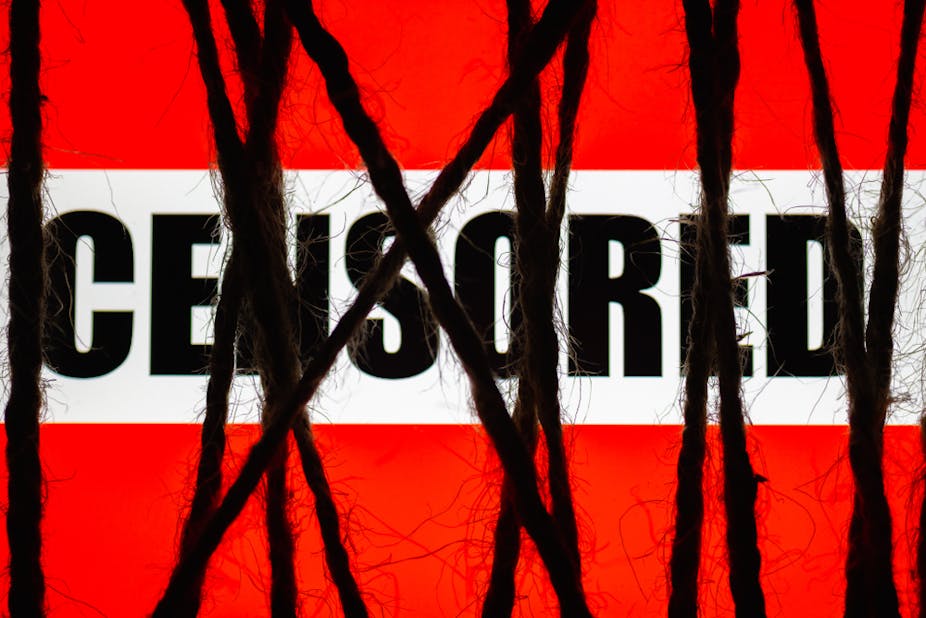
Censorship has been in the news again following Rwanda passing a new law. Shutterstock
Political cartoons are powerful spaces in which negotiations of power and resistance are expressed. They provide insights into power relations, key social issues and events. By mocking or ridiculing the excesses and failings of elites, cartoonists can hold leaders accountable.
While the intent – and reception – of cartoons can mobilise critiques of leaders and excesses of power, they can also be divisive and regressive. This is particularly true when cartoons fail to consider local history, cultural norms, and cultural or religious difference. Recent years have witnessed many of these controversies. These include the publication of editorial cartoons of the Prophet Muhammad in the Danish newspaper Jyllands-Posten which eventually led to protests around the world, including violent demonstrations and riots in some Muslim countries. Or the reaction by women’s groups to South African cartoonist Zapiro’s depictions of former South African President Jacob Zuma “preparing to rape” the “Lady of Justice”. They said it was insensitive in a country where rape is a daily occurrence.
Rwanda has huge sensitivities when it comes to political cartoons. Prior to the 1994 genocide, when an estimated 800,000 Rwandans were killed in the space of 100 days, a cartoon strip in the Kangura newspaper was seen as a propaganda tool to promote division and hostility. This has meant that in recent years, cartoonists remain cautious of crossing official and unofficial lines when covering political issues.
While all journalists try to balance tensions between free speech and causing division, this is particularly fraught for cartoonists. Their work can challenge us to question ourselves, provoke empathy for others and often relies on an emotional reaction – one not always intended to elicit laughter – to convey their argument.
Role of political cartoons
Political and editorial cartoons are a key indicator of the democratic health of a country. They are the “canary in the coal mine”, providing a public display of opposition and dissent. They use a unique art to raise questions and speak a truth to power in ways denied to others. In this role, political cartoonists highlight abuses and excesses of power, and hold governments and leaders accountable.
Witness, for instance, South African cartoonist Zapiro’s many depictions of former President Zuma with a shower faucet attached to his head. These were drawn in the aftermath of Zuma’s rape acquittal. During his court case, Zuma admitted he showered after having unprotected sex as a means to prevent the spread of HIV. Long after the trial, the cartoon continued to act as constant reminder of the rape case, a motif the cartoonist used to question the legitimacy of Zuma’s leadership.
Elsewhere, we see heads of state being ridiculed by being compared to animals: US President George W Bush as an ape, ex-British Prime Minister Tony Blair as a poodle, former Zimbabwean elites as snakes. All these images raised questions about the credibility of powerful office-holders.
Control
Restricting and intimidating political cartoonists is often a key part of broader efforts to curtail press freedoms and free speech.
As elites seek to maintain control, political cartoonists face threats and intimidation for their work. In recent years, we have seen court cases against cartoonists all over the world, including in Malaysia, South Africa, Turkey, and Serbia. In the US contracts have been terminated amid suspicions of political influence.
In the case of Rwanda, the media landscape is marked by restrictions on press freedoms and various forms of censorship. It is classified by the Freedom in the World report as “not free”, alongside countries including Ethiopia, Kazakhstan, and Venezuela. Reporters without Borders ranks Rwanda as 156th in the world for Press Freedoms, comparable with the Democratic Republic of Congo.
But the country’s context is important, the memory of the 1994 genocide remains strong and is ingrained in the national psyche.
Prior to and during the genocide, sections of the print and broadcast media were pivotal in promoting and deepening ethnic division and hostility. Central to such divisive tactics was the presentation of sections of the population as sub-human – as cockroaches – who needed to be exterminated.
It is therefore understandable that, as the country rebuilds, sensitivities remain around representation of individuals or groups which humiliate or degrade them.
Fine line
The critical voice of the political cartoonist can provide a vital safety valve for a society. They can give expression to frustrations, grievances and opposition. But cartoonists need to remain sensitive to local political and social histories.
It’s a fine line between balancing the need to protect free speech and these concerns. Political cartoonists need to continue to speak truth to power, but in so doing must ensure they do not cause division and hostility which may threaten the most fundamental of rights – the right to life.
Daniel Hammett, Lecturer in Development and Political Geography, University of Sheffield
This article is republished from The Conversation under a Creative Commons license. Read the original article.
